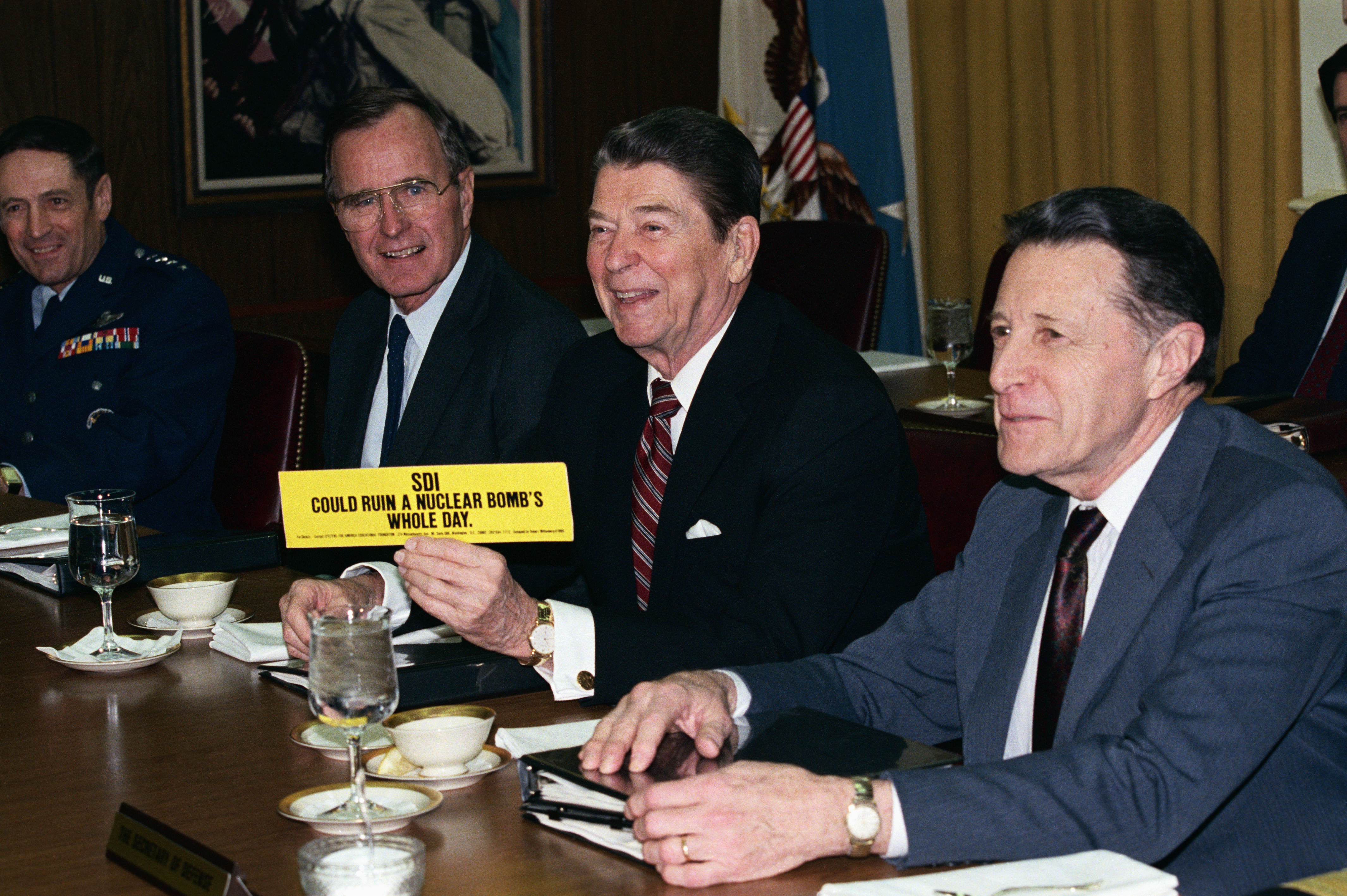23 March 1983: Ronald Reagan launches ‘Star Wars’
US president, Ronald Reagan announced the start of research into the Strategic Defence Initiative (SDI), dubbed “Star Wars” by the press, on this day in 1983.


For almost the entire Cold War, the USA and the Soviet Union had relied on “Mutually Assured Destruction” (Mad) to protect each of them from a nuclear attack from the other. The theory went along the following lines: "You have nuclear weapons. So do I. If you use your nukes against me, I'll use mine against you. So, let's neither of us use them." That works just fine until somebody does use them.
And it wouldn't be just the combatants whose destruction would be assured. You could pretty much kiss the entire planet goodbye. So, as a survival policy, relying on everybody to keep their cool isn't exactly a good one.
Take the infamous false alarm incident of September 1983. Russian lieutenant-colonel Stanislav Petrov had expected another boring day at the office. His job was to keep a look out for incoming American intercontinental ballistic missiles. That day was to be anything but quiet.
MoneyWeek
Subscribe to MoneyWeek today and get your first six magazine issues absolutely FREE

Sign up to Money Morning
Don't miss the latest investment and personal finances news, market analysis, plus money-saving tips with our free twice-daily newsletter
Don't miss the latest investment and personal finances news, market analysis, plus money-saving tips with our free twice-daily newsletter
All of a sudden, he was presented with flashing screens and wailing sirens. "Nuclear warheads on the way", screamed the Soviet Union's early warning system. Luckily for you, me and everyone else on Earth, Petrov decided it was a glitch. He was supposed to have sounded the alarm immediately. A nuclear missile would have taken only 12 minutes to reach Moscow. As it was, World War Three was avoided and Petrov was sacked.
That incident alone underscored the fragility of the nuclear deterrent idea. And US president Ronald Reagan, thought so too. That's why in a speech on 23 March 1983, just six months before Petrov arrived for work, he announced the Strategic Defence Initiative (SDI). Gleefully dubbed "Star Wars" by the press, the idea was to construct a defensive system capable of destroying nuclear-armed ballistic missiles in space before they could re-enter the atmosphere and hit their target.
The Soviets, however, didn't see it that way. The United States, they feared, was trying to gain a knock-out advantage that would render them vulnerable to attack. No weapon is ever purely defensive after all. Nor did it help that Reagan referred to the Soviet Union as the “Evil Empire”. The Soviet Union responded by researching a similar system of its own, but, ironically, the massive costs contributed to its own downfall in 1991.
With no clear enemy, President George HW Bush downgraded the plans to national missile defence (NMD) home and shorter-ranged defence. The Congressional Budget Office reckoned that NMD would cost around $29.5 billion between 1996 and 2015. As for satellites shooting down nuclear-armed ballistic missiles in the 1980s, that was always going to be more Star Wars than feasible reality.
Get the latest financial news, insights and expert analysis from our award-winning MoneyWeek team, to help you understand what really matters when it comes to your finances.

-
 RICS: Budget failed to boost property market and recovery unlikely until spring 2026
RICS: Budget failed to boost property market and recovery unlikely until spring 2026Data from the Royal Institution of Chartered Surveyors suggests the Autumn Budget hasn't helped to improve property market sentiment
-
 FCA launching targeted support to help savers with complex financial decisions
FCA launching targeted support to help savers with complex financial decisionsThe regulator wants to help you get to grips with investing and pension planning. Here’s how its new targeted support framework will help you
-
 31 August 1957: the Federation of Malaya declares independence from the UK
31 August 1957: the Federation of Malaya declares independence from the UKFeatures On this day in 1957, after ten years of preparation, the Federation of Malaya became an independent nation.
-
 13 April 1960: the first satellite navigation system is launched
13 April 1960: the first satellite navigation system is launchedFeatures On this day in 1960, Nasa sent the Transit 1B satellite into orbit to provide positioning for the US Navy’s fleet of Polaris ballistic missile submarines.
-
 9 April 1838: National Gallery opens in Trafalgar Square
9 April 1838: National Gallery opens in Trafalgar SquareFeatures On this day in 1838, William Wilkins’ new National Gallery building in Trafalgar Square opened to the public.
-
3 March 1962: British Antarctic Territory is created
Features On this day in 1962, Britain formed the British Antarctic Territory administered from the Falkland Islands.
-
10 March 2000: the dotcom bubble peaks
Features Tech mania fanned by the dawning of the internet age inflated the dotcom bubble to maximum extent, on this day in 2000.
-
9 March 1776: Adam Smith publishes 'The Wealth of Nations'
Features On this day in 1776, Adam Smith, the “father of modern economics”, published his hugely influential book The Wealth of Nations.
-
 8 March 1817: the New York Stock Exchange is formed
8 March 1817: the New York Stock Exchange is formedFeatures On this day in 1817, a group of brokers moved out of a New York coffee house to form what would become the biggest stock exchange in the world.
-
7 March 1969: Queen Elizabeth II officially opens the Victoria Line
Features On this day in 1969, Queen Elizabeth II took only her second trip on the tube to officially open the underground’s newest line – the Victoria Line.